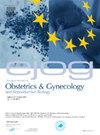各国经阴道宫颈长度常规测量和早产预防干预措施的差异
IF 2.1
4区 医学
Q2 OBSTETRICS & GYNECOLOGY
European journal of obstetrics, gynecology, and reproductive biology
Pub Date : 2024-11-04
DOI:10.1016/j.ejogrb.2024.11.005
引用次数: 0
摘要
研究设计于 2023 年 8 月至 10 月间向欧洲自发性早产大会的代表们发出了一份匿名数字问卷。评估的结果包括方法、适应症(即有或无早产史的女性单胎妊娠,或多胎妊娠)、常规宫颈长度测量的时间和频率、为宫颈过短或有早产史的孕妇提供的干预措施,以及关于身体活动和性活动的建议。结果本研究共接触了 247 名欧洲自发性早产大会的来访者,有 103 名(42%)代表 15 个国家的参与者填写了问卷。大多数参与者在公立/大学医院工作(54 人,占 53%),并且是专科医生(注册医师或顾问;84 人,占 82%)。大多数国家采用直线法测量宫颈,不测量宫颈峡部,但各国的测量方法也不尽相同。对于未患过宫颈锥切或多胎妊娠的妇女,很少在妊娠头三个月进行常规宫颈长度测量。对于有宫颈锥切病史的妇女,6 个国家的 39 个(38%)受访者表示在妊娠头三个月开始进行连续的宫颈测量,14 个国家的 99 个(96%)受访者表示在妊娠后三个月开始进行连续的宫颈测量。对有 PTB 风险的妇女的随访主要是每两周一次(40 人,占 39%)或每月一次(14 人,占 14%)。不过,随访通常根据患者的病史和/或宫颈长度进行个性化安排。对于有先兆流产史或宫颈过短的妇女,可通过阴道注射黄体酮(人数=99,96%),但剂量在每天 100 毫克至 400 毫克之间。各国提供阴道子宫颈环扎术(一级/二级/三级)的时间和孕周存在很大差异(例如,二级子宫颈环扎术的孕周可达 24-28 周)。结论:在宫颈长度测量的适应症和时间以及干预措施方面,各国之间和各国内部存在巨大差异。有必要在现有证据的基础上,采用更通用的方法来管理宫颈息肉高危患者。本文章由计算机程序翻译,如有差异,请以英文原文为准。
Variation between countries for routine transvaginal cervical length measurement and interventions to prevent preterm birth
Objective
To assess the variation between countries for routine transvaginal ultrasound assessment of the cervical length and interventions offered to prevent preterm birth (PTB).
Study Design
An anonymous digital questionnaire was sent out between August and October 2023 to delegates of the European Spontaneous Preterm Birth Congress. Outcomes assessed included method, indications (i.e. singleton pregnancy in women with or without a history of PTB, or a multiple pregnancy), timing and frequency of routine cervical length measurement, interventions offered to pregnant women with a short cervix or a history of PTB, and advice on physical- and sexual activity.
Results
In total, 247 visitors of the European Spontaneous Preterm Birth Congress were approached for this study and 103 (42 %) participants completed the questionnaire representing 15 countries. Most participants worked in a Public/University hospital (n = 54, 53 %) and worked as a specialist (registrar or consultant; n = 84, 82 %). In most countries, the cervix was measured via a straight-line method without the cervical isthmus, but variety existed also within countries. Routine cervical length measurement in women with no prior PTB or a multiple pregnancy is rarely performed in the first trimester. For women with a history of PTB, 39 (38 %) respondents from six countries reported to start serial cervical measurement in the first trimester and 99 (96 %) from 14 countries in the second trimester. Follow-up for women at risk for PTB mainly occurs fortnightly (n = 40, 39 %) or monthly (n = 14, 14 %). However, follow-up is often individualized according to patient’s history and/or cervical length. In women with a history of PTB or a short cervix progesterone is administered vaginally (n = 99, 96 %), however dosage vary between 100 mg and 400 mg daily. The timing and gestational age at which a (primary/secondary/tertiary) vaginal cerclage is offered widely differ between countries (e.g. up to 24–28 weeks of gestation for a secondary cerclage). Advice on restrictions regarding sexual activity in pregnancy is frequently prescribed for women with a short cervix (n = 38, 37 %).
Conclusion
Substantial variation exist between and within countries regarding the indications and timing of cervical length measurement and interventions offered. There is a need for a more universal approach to manage patients at risk for PTB based on the existing evidence.
求助全文
通过发布文献求助,成功后即可免费获取论文全文。
去求助
来源期刊
CiteScore
4.60
自引率
3.80%
发文量
898
审稿时长
8.3 weeks
期刊介绍:
The European Journal of Obstetrics & Gynecology and Reproductive Biology is the leading general clinical journal covering the continent. It publishes peer reviewed original research articles, as well as a wide range of news, book reviews, biographical, historical and educational articles and a lively correspondence section. Fields covered include obstetrics, prenatal diagnosis, maternal-fetal medicine, perinatology, general gynecology, gynecologic oncology, uro-gynecology, reproductive medicine, infertility, reproductive endocrinology, sexual medicine and reproductive ethics. The European Journal of Obstetrics & Gynecology and Reproductive Biology provides a forum for scientific and clinical professional communication in obstetrics and gynecology throughout Europe and the world.

 求助内容:
求助内容: 应助结果提醒方式:
应助结果提醒方式:


